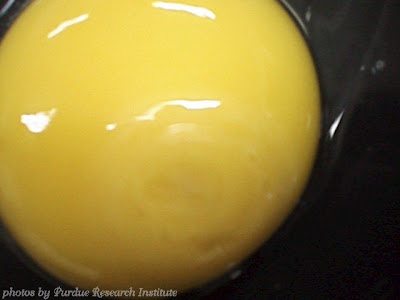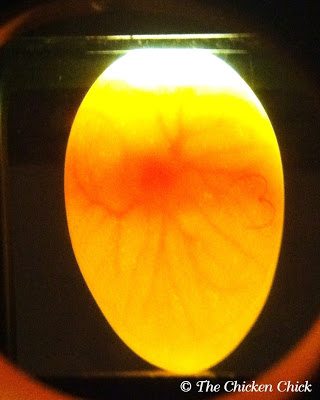There are a few common misconceptions about fertilized eggs that I hope to clear up in this article, but first, it is important to understand the differences between fertilized and unfertilized eggs as well as incubated and un-incubated fertilized eggs.
UNFERTILIZED EGGS
A hen must mate with a rooster in order for her egg to contain both the male and female genetic material necessary to create an embryo inside the egg. An unfertilized egg contains only the hen’s genetic material, which means a chick can never hatch from that egg. The hen’s genetic material, termed the blastodisc, can be identified on an egg yolk as a light-colored dot with irregular borders. Every egg contains a blastodisc.
FERTILIZED EGGS
When an egg is fertilized by a rooster, the blastodisc becomes known as the blastoderm, which is the first stage of embryonic development. The blastoderm is identified by its bullseye appearance, having regular, concentric circles. The blastoderm will remain in a state of suspended animation, so to speak, forever unless warmed at particular temperatures for several hours. When a fertile egg is incubated under precise, steady temperatures and humidity levels for 21 days, the blastoderm may develop into a chick.
INCUBATED FERTILIZED EGG
A fertilized egg must be kept at a temperature of at least 85°F for several hours in order for the blastoderm to begin developing into an embryo.
UN-INCUBATED FERTILIZED EGG
A fertilized egg that is never incubated will never contain an embryo and will never look like anything other than common breakfast food.
MYTHS & FACTS ABOUT FERTILIZED EGGS
MYTH: A fertilized egg has a baby chick in it.
FACT: Freshly laid eggs can never contain a chick. Only fertilized eggs that have been incubated under proper conditions can become an embryo and develop into a chick. To see exactly how an embryo develops, from the inside and out, each of the 21 days until it hatches, click here.
MYTH: Fertilized eggs are more nutritious than unfertilized eggs.
FACT: There is no scientific evidence that fertilized eggs are nutritionally superior to unfertilized ones. Fertilized eggs have remnants of the male’s sperm and a small layer of cells that could form the embryo. The proportion of these to the total egg is so small that it is impossible to detect chemical differences between fertile and infertile eggs.1
MYTH: Fertilized eggs taste different from infertile eggs.
FACT: There is absolutely no flavor difference between fertilized and unfertilized eggs.
MYTH: A blood spot inside the egg means the egg is fertilized.
FACT: A blood spot inside an egg can occur at various points in a hen’s reproductive system as a result of a blood vessel rupturing. It can be the result of a genetic predisposition, a vitamin A deficiency, or a random event. There is no correlation between blood spots and fertilized eggs. The misconception may have come about due to the appearance of incubated, fertilized eggs developing veins at or around day four into incubation. Veining looks nothing like a blood spot, however.
The blood in the following photo of an unincubated egg is NOT a developing embryo. The blood has nothing to do with the egg being fertilized or not fertilized, it was caused by a glitch that occurred while the yolk was being released from the hen’s ovary and would have occurred whether or not a rooster mated with the hen that laid this egg.
Looking for Walmart coupons? Save big on your next Walmart shopping trip with The Chicken Chick’s exclusive coupon codes and promotions. Don’t miss out and start saving today!
MYTH: Candling an egg will reveal whether the egg is fertilized or not. (Candling is the term used for shining a light through an eggshell to see what’s inside.)
FACT: Only eggs that are incubated and begin developing can be identified as fertilized after a minimum of 3 days. Neither the blastoderm nor a blastodisc can be seen through the shell. It is possible for an incubated egg to be fertilized and appear unfertilized when candled if the egg failed to develop. The only way to determine whether an unincubated egg is fertilized is to crack it open and identify the blastodisc or blastoderm.
Sources & further reading
Kathy Shea Mormino
Affectionately known internationally as The Chicken Chick®, Kathy Shea Mormino shares a fun-loving, informative style to raising backyard chickens. …Read on


shop my SPONSORS
There are a few common misconceptions about fertilized eggs that I hope to clear up in this article, but first, it is important to understand the differences between fertilized and unfertilized eggs as well as incubated and un-incubated fertilized eggs.
UNFERTILIZED EGGS
A hen must mate with a rooster in order for her egg to contain both the male and female genetic material necessary to create an embryo inside the egg. An unfertilized egg contains only the hen’s genetic material, which means a chick can never hatch from that egg. The hen’s genetic material, termed the blastodisc, can be identified on an egg yolk as a light-colored dot with irregular borders. Every egg contains a blastodisc.
FERTILIZED EGGS
When an egg is fertilized by a rooster, the blastodisc becomes known as the blastoderm, which is the first stage of embryonic development. The blastoderm is identified by its bullseye appearance, having regular, concentric circles. The blastoderm will remain in a state of suspended animation, so to speak, forever unless warmed at particular temperatures for several hours. When a fertile egg is incubated under precise, steady temperatures and humidity levels for 21 days, the blastoderm may develop into a chick.
INCUBATED FERTILIZED EGG
A fertilized egg must be kept at a temperature of at least 85°F for several hours in order for the blastoderm to begin developing into an embryo.
UN-INCUBATED FERTILIZED EGG
A fertilized egg that is never incubated will never contain an embryo and will never look like anything other than common breakfast food.
MYTHS & FACTS ABOUT FERTILIZED EGGS
MYTH: A fertilized egg has a baby chick in it.
FACT: Freshly laid eggs can never contain a chick. Only fertilized eggs that have been incubated under proper conditions can become an embryo and develop into a chick. To see exactly how an embryo develops, from the inside and out, each of the 21 days until it hatches, click here.
MYTH: Fertilized eggs are more nutritious than unfertilized eggs.
FACT: There is no scientific evidence that fertilized eggs are nutritionally superior to unfertilized ones. Fertilized eggs have remnants of the male’s sperm and a small layer of cells that could form the embryo. The proportion of these to the total egg is so small that it is impossible to detect chemical differences between fertile and infertile eggs.1
MYTH: Fertilized eggs taste different from infertile eggs.
FACT: There is absolutely no flavor difference between fertilized and unfertilized eggs.
MYTH: A blood spot inside the egg means the egg is fertilized.
FACT: A blood spot inside an egg can occur at various points in a hen’s reproductive system as a result of a blood vessel rupturing. It can be the result of a genetic predisposition, a vitamin A deficiency, or a random event. There is no correlation between blood spots and fertilized eggs. The misconception may have come about due to the appearance of incubated, fertilized eggs developing veins at or around day four into incubation. Veining looks nothing like a blood spot, however.
The blood in the following photo of an unincubated egg is NOT a developing embryo. The blood has nothing to do with the egg being fertilized or not fertilized, it was caused by a glitch that occurred while the yolk was being released from the hen’s ovary and would have occurred whether or not a rooster mated with the hen that laid this egg.
Looking for Walmart coupons? Save big on your next Walmart shopping trip with The Chicken Chick’s exclusive coupon codes and promotions. Don’t miss out and start saving today!
MYTH: Candling an egg will reveal whether the egg is fertilized or not. (Candling is the term used for shining a light through an eggshell to see what’s inside.)
FACT: Only eggs that are incubated and begin developing can be identified as fertilized after a minimum of 3 days. Neither the blastoderm nor a blastodisc can be seen through the shell. It is possible for an incubated egg to be fertilized and appear unfertilized when candled if the egg failed to develop. The only way to determine whether an unincubated egg is fertilized is to crack it open and identify the blastodisc or blastoderm.
Sources & further reading














































That’s kinda messed up!
Thank You ChickenChick, \i had horrible discussion with 2 women about fertilized and unfertilized eggs in supermarket. I personally don’t care what eggs I buy, it was just that one of the women made a problem out of it and it was infuriating. That person was pretending that i DO have a position on it when, I didn’t and I stated that, I don’t care.
Snake mentality will show itself up, not only as Judas, but even in petty, insignificant things like this because, snakes live only to manipulate, lie and stir quarrels.
Thank you.
Hello can I Oder hatching eggs by post did they bee good for hatching ?
please help..I have 5 chickens, 4 Hens and 1 rooster, I have always had 4 beautiful orange/yellow eggs every day for the last 6 to 8 months but in the last week or so the eggs seem very bloody. They look perfectly normal until the yoke is broken and it seems very red. no spotting noticeable before the yoke is broken, my family will no longer eat the eggs because of this. Not sure if its just one chickens eggs or all of them. Eggs are now being eaten by the dog !!!!!
Everything in my life was falling apart since i was unable to give my lover in our marriage.My life bounced back the day i came across PROPHETESS MASADE contact details on the internet. When i contacted PROPHETESS MASADE that faithful day i was so suprised that just within 2weeks that i contacted PROPHETESS MASADE i got a surprising result that is i got pregnant. Since that very moment i promised myself that i was going to try my best that everybody that are heart broken should be able to find PROPHETESS MASADE contact details on all almost every site on… Read more »